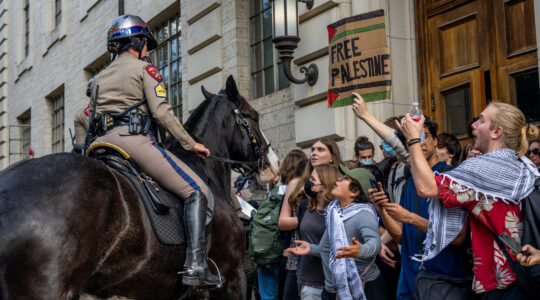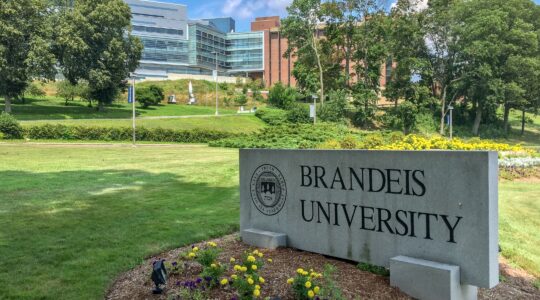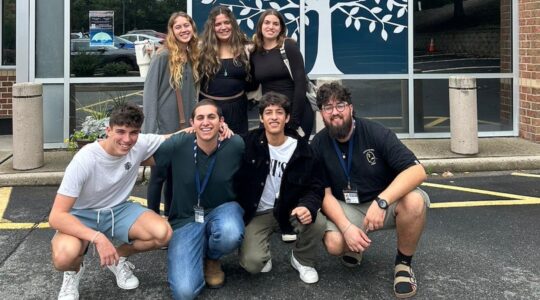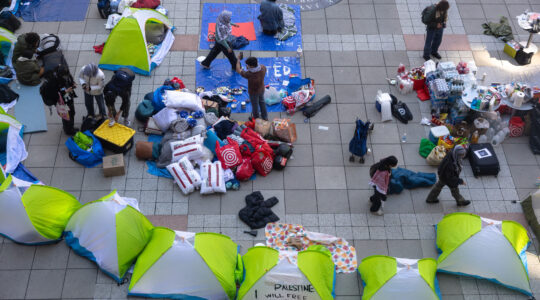BERKELEY, Calif. (JTA) – Aaron Alexander brought a traditional Druze melody from Mount Meron.
Jewlia Eisenberg brought a poem by Palestinian nationalist poet Mahmoud Darwish.
Mariana Sadovska brought Ukrainian calling songs and Carpathian wedding music, while Avi Avital brought a Macedonian folk tune he’d heard at a festival in Safed.
These four holed up last week in a basement room near the University of California campus here with five colleagues – all of them innovative, world-class musicians – to create a new piece of Jewish music to be performed as the finale of this city’s 23rd annual Jewish Music Festival.
Sadovska brought her harmonium, John Schott brought his guitars and balalaika. Avital had his mandolin, Jessica Ivry her cello, Stuart Brotman his bass fiddle and Glenn Hartman his accordion and trombone.
They worked, sequestered, with the music, lyrics and ideas they had gathered from their respective homes in the Bay Area, New York, Italy and Germany.
Singing in five languages, they mixed klezmer with Ladino, threw in Eastern European melodies and songs from the Moroccan souk, and sprinkled it with blues from the Mississippi Delta and cutting-edge contemporary jazz.
Valiantly trying to harness the creative energy was trumpeter, bandleader and composer Frank London, a member of the Grammy Award-winning group the Klezmatics, entrusted by festival director Ellie Shapiro with the task of whipping the project into shape.
For a week they tinkered, scribbled and jammed while downing lots of coffee, and on March 29 at the Jewish Community Center of San Francisco, to rousing applause they presented “Cyclical Rituals (Part I): Spring,” a concert in nine, 10 or possibly 11 parts.
An excerpt from “Cyclical Rituals.”
This extraordinary undertaking is believed to be the first of its kind – a Jewish music festival in the United States sponsoring a group of musicians to come together to create a new piece of Jewish music.
Shapiro, who with London invited the participants and raised the money for their weeklong artistic incubation as part of her position at the JCC of the East Bay, says she came up with the idea while attending the Krakow Jewish Cultural Festival in Poland.
Participating musicians after their concerts each night jam in local clubs into the wee hours. The sessions are organized by the festival, but the collaboration is driven by the artists.
“It was a convergence of my thinking that music is about building community,” Shapiro said. “I got the idea of doing an artist residency, bringing together people who understand and respect traditional music, and are also innovative as musicians and composers.”
Each of the nine had worked with at least one other member of the group before, and some were longtime friends. But they had never worked together as a group until last week.
“Each of us has a different relationship to what Jewish music is,” London said. “I asked people to bring in stuff, and we built on the themes of spring, ritual, cycles, the ark, without specifying what any of that means.”
The collaboration began March 24 when the musicians shared what they had brought and started to build on each other’s contributions.
“It became a winnowing process,” London said. “Some things dropped out, sometimes we took the text from one person and put it in someone else’s piece.”
By the end of the week they were still writing new parts and had yet to play the entire piece.
Late Friday morning the group was rehearsing a difficult passage in Avital’s “Macedonia,” a fast-paced folk tune. Avital strummed furiously on the mandolin and Alexander was keeping time on the hand drum while Brotman plucked the strings of his electric bass. Hartman was having trouble with the accordion solo, his brow furrowed with frustration.
The group stopped playing.
“You’re fired,” Schott deadpanned.
Avital explained what he wanted from the piece – each musician took charge of his or her own contribution – and the rehearsal began again. This time Schott, on electric guitar, lost his fingering.
“I don’t think I’m going to get that,” he muttered. “I’m just not going to get it. I fire myself.”
Later that afternoon, members of the group expressed varying levels of readiness for the next night’s show.
Asked to rate his preparedness on a scale of 1 to 20, Schott put his own level at the high mark of 20. But he added, “I’m always ready, I don’t aim for that kind of perfection. I’m always ready to pick up my guitar and play for you, for me, for whoever’s there.”
Somehow the show came together on Saturday night. The pieces segued seamlessly one into the other, the lighting was flawless and the sound system worked.
Showered and shaved, their shoes back on, the musicians played as if they had known the music for years – as if they had actual scores in front of them instead of hastily compiled hand-written notes.
Although many in the audience didn’t fully grasp what they were watching, those who knew and had seen the work in its various stages of undress were moved by watching the birth of a new piece of Jewish music – a birth supported by Jewish communal institutions and donors who understood the importance of financing Jewish cultural creativity.
These were folks who gave the money and then backed off, trusting in the artists to invent something of meaning.
The group already has been invited to perform the piece at this summer’s Krakow festival, and Shapiro hopes to repeat the project next year – if she can raise the money again.
“For a very small organization to take on such an undertaking was very ambitious,” she said. “I’m glad we did it. It’s time that the Jewish world acknowledge the cultural figures that are sustaining us.”





